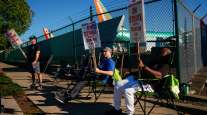Payrolls, Wages Cool While Unemployment Rate Hits 48-Year Low

Federal Reserve Chairman Jerome Powell says the link between unemployment and inflation may be resting rather than poised for a revival. The jobless rate’s decline to a 48-year low will put that view to the test.
While unemployment fell more than forecast in September to 3.7%, the lowest since December 1969, average hourly earnings climbed 2.8% from a year earlier, slowing as projected from a 2.9% advance the prior month, a Labor Department report showed Oct. 5. Hiring eased to 134,000, reflecting the fallout from Hurricane Florence, with 299,000 people being away from work due to bad weather.

Federal Reserve Chairman Jerome Powell. (Elise Amendola/Associated Press)
The figures suggest the job market remains tight — with hiring outpacing labor-force growth and perhaps pushing the economy beyond full employment — though it has yet to spark a significant acceleration in wages. The coming months will indicate whether pay gains and prices finally will surge in response to an unemployment rate of historic proportions, a development Powell says he doesn’t expect.
“The jobs report these days has become more about inflation than payrolls,” and “the big picture should ease concerns about inflation,” said Russell Price, a senior economist at Ameriprise Financial Inc. in Detroit. “Wages are creeping higher, not accelerating,” he said. “This report should keep the Fed on their current course, of one hike per quarter.”
The latest jobless-rate drop pushed it further below Fed estimates of levels sustainable in the long run, reinforcing expectations for a fourth interest-rate hike this year and more in 2019. While the trade war with China poses a risk, policymakers are likely to keep raising borrowing costs as President Donald Trump’s tax cuts are juicing economic growth and supporting demand for labor, though employers are lifting worker pay only gradually.
Even so, the third-quarter annualized wage gain of 3.4% was the fastest of the expansion, and October is poised to register a year-over-year increase of above 3%, according to Michael Feroli, chief U.S. economist at JPMorgan Chase & Co. Analysts at Morgan Stanley made a similar projection, saying a post-hurricane monthly wage drop in October 2017 will make the annual comparison more favorable for the next reading.
Market Reaction
After the Oct. 5 report, Treasury yields rose to seven-year highs amid speculation the figures will clear the path for higher interest rates.
“I do not see it as likely that the Phillips curve is dead, or that it will soon exact revenge,” Powell said in a speech to economists Oct. 2, referring to the theory that lower unemployment spurs higher inflation.
The report keeps alive the debate about how much slack still may be left in the labor market, and whether the reality matches the Fed’s own estimates of the jobless rate under which inflation would start picking up — the so-called non-accelerating inflation rate of unemployment, or Nairu.
“If the labor market were as tight as implied by the Fed’s estimate of full employment, job growth this strong would likely place significant upward pressure on wages,” Mickey Levy, chief U.S. and Asia economist at Berenberg Capital Markets in New York, said in a note. “As business demand for workers continues to rise, attractive wages and benefits are luring a growing number of persons from the sidelines back into the workforce.”
Some companies are starting to boost wages — Amazon.com being among the latest to pledge raises — to attract or retain workers.

Three-month avgerage of jobs added to payroll.
Analysts chalked up the slower hiring to the hurricane and pointed to strength in revisions, which added a total of 87,000 jobs to payrolls in the previous two months. The August gain rose to 270,000, bringing the three-month average to 190,000. Hiring data may show storm-related swings for October too, economists said.
“I would view this as a full-employment jobs report,” Alan Krueger, a Princeton University economics professor and former head of the White House Council of Economic Advisers under Barack Obama, said on Bloomberg Television. “It’s going to reinforce the Fed’s path for raising rates.”
The fallout from Florence, which made landfall in North Carolina on Sept. 14, was apparent in employment at restaurants and bars, an industry where most workers only get paid if they show up to work. That category saw an 18,200 decrease in payrolls, according to the report.
What Our Economists Say
Average hourly earnings rose 0.3% from the prior month, matching estimates, after a downwardly revised 0.3% gain. The annual advance of 2.8% matched economist projections for some cooling in the year-over-year rise, as a strong number for September 2017 wages presented a difficult comparison.
Some measures showed the labor market may still have some room for further improvement. The U-6, or underemployment rate, edged up to 7.5% from 7.4%. That gauge includes part-time workers who would prefer a full-time position and people who want a job but aren’t actively looking.
The prime-age participation rate, or share of people 25 to 54 years old in the labor force, fell to 81.8% in September and has ticked down in all except three months this year.
“We hear employers complaining they’re having trouble, but we don’t see any evidence in the jobs data,” Julia Coronado, president of MacroPolicy Perspectives and a former Fed economist, said on Bloomberg TV. “And wage growth remains subdued, which means there’s no real inflationary pressures or tightness that’s starting to constrain and maybe worry the Fed.”




